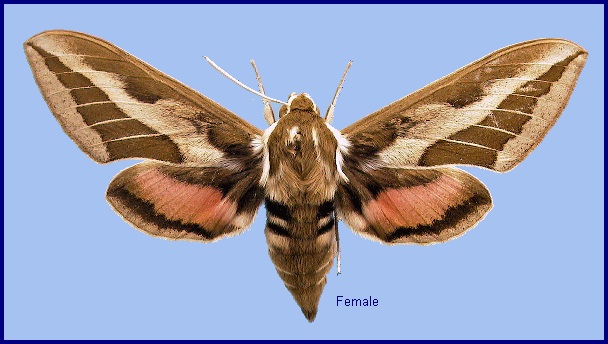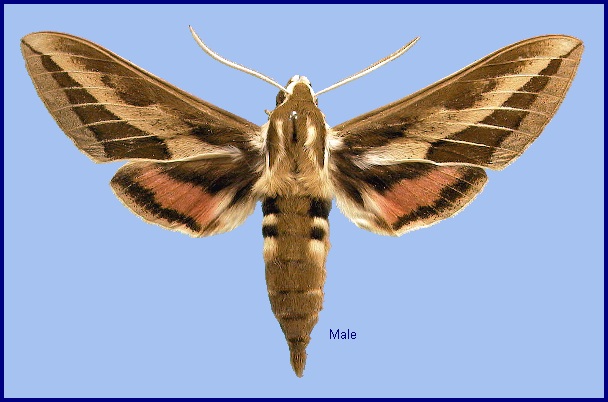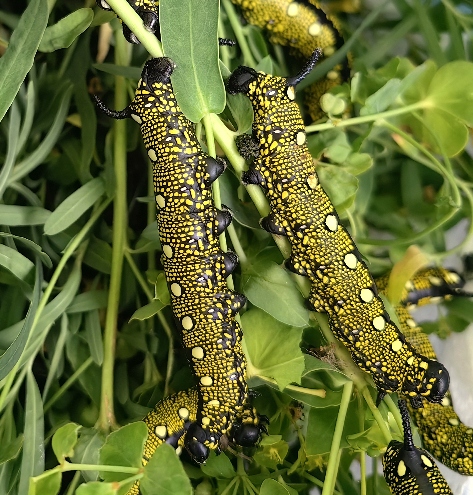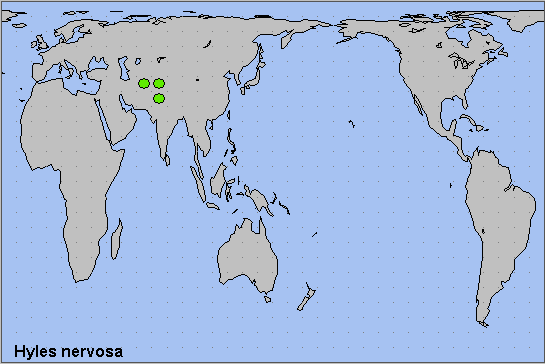

Celerio euphorbiae nervosa Rothschild & Jordan, 1903, Novit. zool. 9 (suppl.): 721. Type locality: [Northwest India, Himachal Pradesh,] Sabathu.
Synonym. Celerio euphorbiae nervosa Rothschild & Jordan, 1903.
Note. In China this species has been confused with Hyles costata/Hyles exilis and therefore published information is not reliable.
Wingspan: 68--87mm. Forewing costal area clay-coloured from base to near apex, broadly shaded with black behind from base to Cu2, then sinuate; in this sinus an indistinct black patch; the patch beyond apex of cell merged together with costal area, edged with black behind; veins outlined with white in the post-discal area; a small white patch at base of wing; median area pinkish; a broad, flesh-coloured marginal band, sometimes dotted with black. Hindwing crimson, basal area and a narrow, scalloped, submarginal band dark brown or blackish; a broad marginal band pink dotted with black. Underside of wings speckled with brown; cell of forewing brown, the area ending in a blackish patch; disc of forewing slightly pink, that of hindwing pale pink. Head and thorax olive, scaling of antenna white; palpus white, with a white lateral stripe from palpus over the eye to the end of the thorax, where it meets the white upper border of the tegula. In the male, the tegulae are fringed with white, the abdomen has only two black lateral spots basally, and the fringes of the tergites are not white along the dorsal ridge (Bell & Scott, 1937).


A local species, but which can occur in very large numbers in a given area. In Kashmir and Himachal Pradesh, generally occurring at 2500--3234m (Bell & Scott, 1937) where stands of herbaceous Euphorbia are common up into the subalpine zone.
Apparently trivoltine in Kashmir; March to May, June/July and September. No reliable information is available for China.
OVUM: Pale green and very like that of Hyles euphorbiae euphorbiae, almost spherical, shiny but surface minutely pitted. Laid in small clusters of up to twenty on the young shoots of the hostplant (Bell & Scott, 1937).

LARVA: Full-fed 80mm. According to Bell & Scott (1937), in the first instar the 4mm-long larva is off-white with a black horn and head. The coloration of the final instar, which is primarily black with small white to pale yellow spots, begins to show in the second instar. A dorso-lateral line of single, white eye-spots, one per segment, runs from the white-speckled head to the jet black horn. The shield, anal claspers and prolegs are black. An unbroken dorsal line of the same colour stretches from head to horn, with projections to the eye-spots on either side. In most there is also a noticeable ventro-lateral line of medium-sized yellow spots, although these can be very small. Spiracles white. This colour scheme is constant, with little or no variation, unlike that of Hyles euphorbiae.
In shape, head broad semi-elliptical, dorsal line very slightly depressed, the vertex of each lobe broadly rounded. True clypeus triangular, longer than broad, apex reaching to nearly the middle of the head; false clypeus with rounded apex reaching to middle of head. Labrum one-third length of clypeus, as broad as clypeus is long, the sides converging frontad; ligula as long as labrum, twice as broad as long, oblong in shape with a small frontal sinus. Cutting-edge of mandible strongly toothed. All the eyes of equal size and rather small. Surface of head moderately shiny, smooth, covered sparsely with short hairs directed frontad. Body moderately shiny, greasy-looking, a transverse row of short hairs along each secondary ring. There is a saddle-shaped mark on segment 2 which is slightly more shiny. Distal two-thirds of anal flap and outer face of base of clasper set sparsely with minute, conical tubercles. Horn short, slightly down-curved, tapering evenly to a blunt point, covered densely with spine-like, outward-directed tubercles.
According to Bell & Scott (1937), the larvae are gregarious and, having stripped one plant of its leaves, move en masse to the next. They feed quite openly, although when nearly full grown they tend to rest along the stems of the hostplant close to the earth. If disturbed, they simultaneously regurgitate drops of green fluid. Such gregarious behaviour is probably a defence against tachinid parasitoids.
Occurs from April to October, most commonly from June to August.


PUPA: 45mm. Very similar to that of Hyles euphorbiae, but head, thorax and wing-case bright green when fresh, duller green later, speckled with brown. Tongue and antenna black; abdomen rusty-red, with a darker, irregular dorsal stripe; depressions between the wrinkles dark brown. Hind bevels of segments 8 to 11 dark brown; ridges in front of 2 rusty, lobe from 3 black; spiracles black; cremaster brown. Head bluntly rounded; hind margin of segment 11 raised and undercut, 12 being slightly telescoped into 11; 8 to 10 slightly flattened dorsally. Antenna equal to fore leg both reaching to middle of wing-case; mid-leg to about three-quarters 'the distance to tip of wing-case; there is a long, narrow coxal piece. Surface slightly shiny; head, thorax and wing-case smooth, abdomen coarsely, transversely wrinkled, and pitted on dorsal surface; front bevels of segments 9 to 11 wrinkled and pitted. Spiracle of 2 a narrow slit, the hind margin of 2 raised into three parallel ridges in front of it a narrow transversely oblong lobe, sloping upwards frontad, projecting from the front margin of 3 behind it. Remaining spiracles oval, slightly depressed and surrounded by concentric wrinkles. Cremaster elongate-triangular, ending in: a short cylindrical shaft with two minute points. The overwintering stage (Bell & Scott, 1937).
Larval hostplants. Herbaceous Euphorbia spp. On Euphorbia wallichii Hook. f. at Janshai Meadow, Swat Valley, Khyber Pakhtunkhwa, Pakistan (Azan Karam, pers. comm. 2022). Presumably also Euphorbia in China.
Unknown for the region.
China: Xizang/Tibet (Xigazê, 3836m; Jiang, 4050m; Yadong, 2900m).
In China this species has been confused with Hyles costata/Hyles exilis and therefore published information is not reliable. However, all records from Xizang/Tibet are probably of this species.
Reliably recorded from eastern Afghanistan (Ebert, 1969), Khyber-Pakhtunkhwa & Azad Jammu and Kashmir, northern Pakistan (Bell & Scott, 1937; Rafi et al., 2014), Jammu and Kashmir/Ladakh, India (Bell & Scott, 1937), Sural in the Pangi Valley of Himachal Pradesh, India (Sidhu, Nair & Kubendran, 2018), and (possibly) the Aravalli Hill range of Rajasthan, India (Dar et al., 2021). This is in addition to the type locality of Sabathu in the Solan District of Himachal Pradesh, India (Rothschild & Jordan, 1903). Also, the extreme west of Xizang Province/Tibet, China. However, the above local distribution data suggests that this species may occur right across southern Xizang/Tibet.

Holarctic; western Palaearctic region. Pleistocene refuge: Monocentric -- northern section of Sindian refuge.
 Return to Sphingidae of the Eastern Palaearctic species list
Return to Sphingidae of the Eastern Palaearctic species list